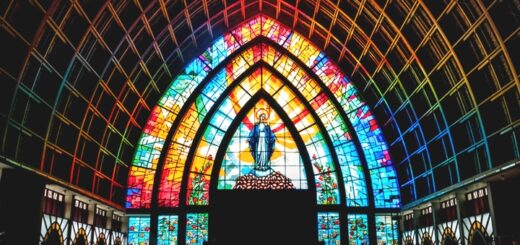Latin America. Sexual diversity and churches of the south of the world
Article by Hugo Cordova Quero* published on the Catholic Bimonthly Mission of July-August 2022, pp.22-24
Sexual diversity has been present on the American continent long before the arrival of European conquerors. Like the Maya and other Mesoamerican cultures, the Aztecs considered sexuality as a fluid, so both heterosexual and homosexual relationships were considered acceptable. For the INSTS, both women and men owned an uterus, where the "seeds" are found, who worked together to produce a new being.
The sign of this complementarity was the "red blood" - menstruation - in females and "white blood" - ejaculation - in males. Only through the combination of both types of "blood" could a new human being arise. However, the Inca men could use leather condoms to avoid mixing the two types of "blood".
Homosexual relationships had a sacred character. They were prohibited after the arrival of the Spanish conquerors, as well as the serving, that is, the year of test expected before the marriage, which was combined, at the end of which the couple could marry or dissolve the relationship without consequences.
The colonial era
In the colonial period three elements emerged that still influence the approach to sexual diversity today.
The paradigm "shame/honor". One of the characteristics of homosexual relationships in Latin America is the sense of vertog. This paradigm implies that the relationships between men and women are marked by honor and shame and this is transferred to those between two men where the "male" represents the "active-perpetuating" and the "female" the "passive-life" ". Therefore being penetrated also entails an abandonment of the virility model imposed by the patriarchal straight ideology and reduces to a level of subordination that betrays the expectation of a donation placed on the shoulders of the males.
The marriage between sexuality and religion: sodomy. The "sodomy" was one of the sins most persecuted by the Spanish inquisition, because medieval European women and men involved in homoerotic activities shocked - through their sexual practices - the social order. When the conquistadors arrived in the Americas and saw that among the conquered peoples the homosexual relationships were not condemned, they began their persecution to eradicate what in their eyes was a "sin", an idea completely unknown to the religious corpus of these peoples.
The "Virgin/whore" dichotomy: the Virgin Mary. The veneration of the Virgin Mary is central to Latin American spirituality. However, a figure who proclaims liberation and resistance, as in the Magnificat (Lk 1,46-55), in colonial times it became a symbol of the submission of women and a clash element for those who intended to "put all women in their place".
Especially in popular religiosity, the image of the Virgin Mary represented the Christian ideal of femininity and maternity, as well as the meter of measurement of what is considered "decent" with respect to what is labeled as "indecent", ending up distinguishing the Women in "Sante" - decent -, while those who refuse this submission are degraded to "whores" - indecent - in a dichotomy that precludes other alternative spaces. This model, close for heterosexual women, is more severe for those whose desire is homoerotic.
Equilitarian marriage and religions in Argentina
Many often wonder if people with sexual diversity can marry. The response implies the socio-legal and religious aspect of the Latin American context. I will choose Argentina as an example, the first country to legalize the egalitarian marriage in Latin America.
Civil marriage
From a socio-legal point of view, the law 26,618 approved by the Argentine parliament on July 15, 2010-commonly called "Equalitaria marriage"-establishes the same rights for Argentini and residents in the country regardless of their sexual orientation. Therefore, people with sexual diversity can access marriage and all the rights associated with it, including that of adopting children.
Argentina is not the only country in the continent to predict egalitarian marriage and others have laws for the recognition of same sex couples: from 2015 Chile has recognized both heterosexual and homosexual civil unions; The Costa Rica admits the equal marriage following the judgment of the Intemeulian Court of Human Rights of 2018, which is binding on the basis of the national constitution; In Colombia a sentence of the 2016 Constitutional Court recognizes the validity of marriages between people of the same sex; Brazil has a sentence of the 2013 judiciary that recognizes homosexual marriage; Ecuador introduced civil unions between people of the same sex in 2014; The French Guyana, as a territory of France, incorporated the homosexual marriage in 2013, as in 2017 the Falkland-Malvinas islands, a British dependence; In Mexico since 2007 the civil unions have been planned in Mexico cities and then in the States of Campeche, Chihuahua, Cohuila, Cohuila de Zaragoza, Colima, Jalisco, Michoacán, Morelos, Nayarit, Quintana Roo and Sonora; In Uruguay the law on egalitarian marriage was approved in 2013.
Religious marriage
Some religious sectors have welcomed the promulgation of these laws while others reject religious marriage between people of the same sex. In Protestantism, many churches have been pioneer. In Argentina, for example, the Church of the Metropolitan Community, the Argentine Methodist Church, the Valdese Evangelical Church of the Rio de la Plata, the Danish Lutheran Church of Buenos Aires, the united Lutheran Evangelical Church and the Evangelical Church of the Rio de la Plata They celebrate homosexual wedding, rejecting exclusions and discrimination.
In some churches, which have detached themselves from the official Catholicism, such as the ancient Catholic Church, the Vetero Apostolic Church in America and the international priestly mission, the sacrament of the marriage between people of the same sex is officious, as well as, in Anglicanism, the Argentine episcopal church free and, in orthodoxy, the Argentine Christian Orthodox Church. These churches have embraced a reading of the biblical texts that includes all people, regardless of sexual orientation.
As for Judaism, the Synagogue NCI-Emanu El of the Jewish Foundation officiated in 2016 Nissu'in (Jewish wedding ceremony) of same sex. The first religious marriage in Buddhism was that of a couple of the same sex that took place in 2006 in La Rioja. In the Umbanda religion, 60 percent of followers are made up of people with sexual diversity, but marriages between people of the same sex are also practiced.
Without convictions and discrimination
In Argentina today there are religious spaces in which non -heterosexual people can live their daily life without being condemned or discriminated against on the basis of the spirituality with which they identify themselves. Non -heterosexual people can also marry both legally and religiously and baptize their children in a Christian community or incorporate them in spiritual life through the rites of other religions.
Identity policy in Latin America
The "Lesbico-Gay" movement of the 70s and 80s of the last century followed a policy based on an "essential" identity, that is, on the idea that there is something intrinsic material to the person-an essence-which conditions the Its existence, defining homosexuality as a fixed and immutable state, a universal phenomenon that has a marginal, but continuous and coherent history.
In the 90s this conceptualization was questioned by the queer theory, according to which identity is fluid, the effect of social conditioning and the cultural models available to understand themselves, and the homosexual acts, having different meanings in different historical contexts, They are not identical in time and space.
Thus, while many Latin American activists fight for the rights of lesbians and gays - with their essentialization of identity - others support a queer perspective that takes into account the fluidity of identity and can be traced back to the arrival of the conquistadors arrival .
Therefore, individuals and queer communities are moving in different and sometimes divergent ways on topics such as egalitarian marriage, the laws on gender identity, the rights of adoption for homoparent families, reproductive rights, the decriminalization of sexual work e The networks of extensive and family -type families.
* Hugo Cordova Quero is Argentine Bishop of the ancient Church of the Americas - an independent Catholic Church, founded in 2016 - and director of online training and visiting professor of critical theories and theologies at the Starr King School of the Graduate Theological Union University of Berkeley, in California, where he achieved his doctorate in interdisciplinary studies on religion, ethnicity and migration and in systematic theology and critical theories (feminists, queer and postcolonial).






